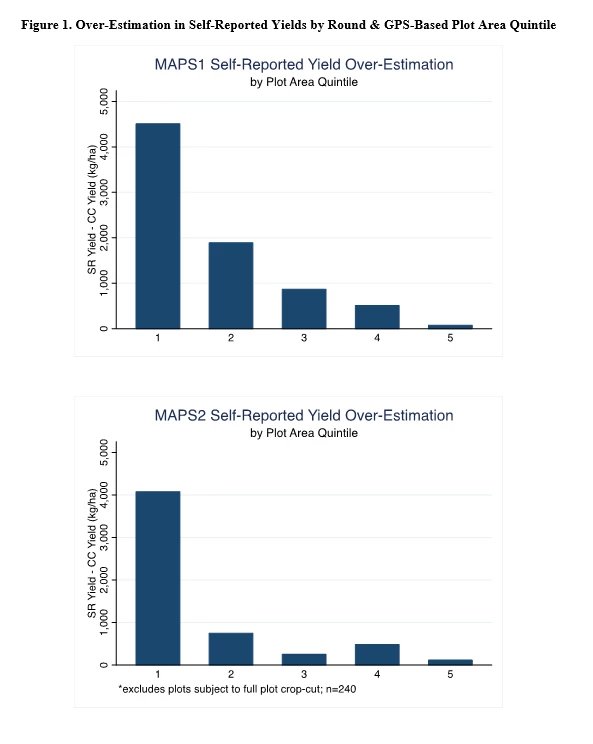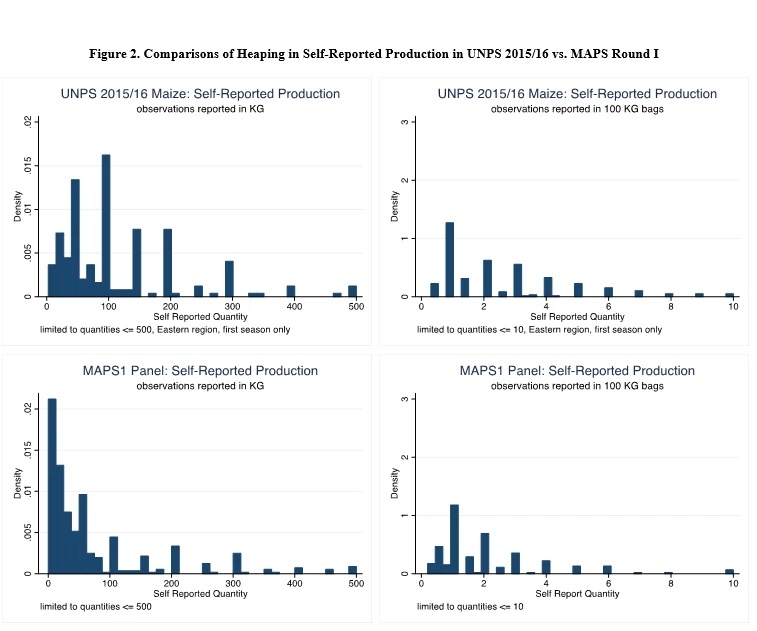One of the most storied topics in agricultural economics, dating back to Chayanov’s work on Russian peasants published nearly a century ago, is the inverse relationship between scale (in terms of farm or plot size) and (land) productivity - commonly known as the IR.
If smallholders are in fact more efficient than their larger counterparts, governments should encourage redistribution of land. The existence of the IR could further temper concerns around plots becoming smaller or, more broadly, “small” plots, shown to be managed more often by females and poorer farmers.
Today, we share our new paper on the topic and the conclusion that the IR is a statistical artifact in our study area in Uganda, driven by measurement error in farmer-reported crop production. We are the first, along with Desiere and Jolliffe, to provide such evidence, and we do so by ruling out several previous hypotheses on the IR.
Why worry about farmer-reported crop production?
Previous studies in support of the IR measure land productivity based on farmer-reported production, which is convenient and yet exceptionally complicated to solicit, particularly in Africa. Besides the potential biases associated with recall, intentional misreporting, and inclination to round off numbers (shown by Carletto et al. (2015) for land areas), farmers frequently utilize non-standard measurement units for production quantification. These units vary across countries; often exhibit within-country variation across space and time; and must either be monetized or converted into kilograms. In case of kilogram conversion, one needs crop-condition-unit-specific conversion factors - often either unavailable or available but not documented and/or suspected to be in need of validation. These issues are reviewed in detail by Oseni et al. (2017).
The set-up
Our paper is based on MAPS: Methodological Experiment on Measuring Maize Productivity, Soil Fertility and Variety. MAPS was conducted in the first rainy seasons of 2015 and 2016 as part of a partnership between the LSMS and the Uganda Bureau of Statistics. It aimed to test the accuracy of subjective survey methods compared to their objective counterparts in three domains: (1) maize production and yield measurement, (2) soil fertility assessment, and (3) maize variety identification.
Our analysis is based on a two-round panel of 440 maize farming households, across 45 enumeration areas in a 400 km2 area spanning Iganga and Mayuge districts of Eastern Uganda; the leading maize-producing region in the country. In each sampled household, one maize plot was selected at random in each round, for which we obtained maize production and yield estimates based on (1) farmer reporting; (2) sub-plot crop cutting; (3) full-plot crop cutting, and (4) high-resolution satellite imagery-based remote sensing. Our yield measures, irrespective of the approach to production measurement, were anchored in GPS-based plot area measurement.
The key findings
In each round, the overall self-reported maize yield is, on average, at least 85 percent higher than the ones based on crop cutting and remote-sensing, with direct implications for the IR.
While farmer-reported production-based plot-level maize yield regressions consistently imply diminishing returns to GPS-based plot area, the comparable regressions estimated with maize yields based on sub-plot crop cutting, full-plot crop cutting, and remote sensing consistently point towards constant returns to scale.
Irrespective of panel estimation and the exhaustive list of plot-level controls, including objective measures of soil fertility and edge effects (in view of the previous hypotheses), the IR exists while using farmer-reported maize production, and ceases to do so when maize yield is anchored in objective methods.
The drivers of measurement error
These findings are driven by over-estimation of farmer-reported maize production and yield vis-à-vis crop cutting, particularly in the lower half of the plot area distribution (Figure 1).
Besides plot area, the analysis points to the following key factors contributing to over-estimation: rounding of maize production; omission of crop damage omit when reporting production; and multiple harvests (and the accompanying heterogeneity in harvested crop conditions). The results also refute the claim that over-estimation is driven by the inability of farmers to distinguish production at the plot-, rather than farm-, level.
The implications
Together with the similarities in rounding in self-reported maize production information across our study and the Eastern region sub-sample of the Uganda National Panel Survey for the same season (Figure 2), our findings emphasize the need for improving crop production and yield measurement in surveys.
Given the absence of the IR based on objective productivity measures, the results provide further support for promoting a policy environment that reduces the scope for further subdivision of land. The findings do not, however, suggest a shift in policy focus from the needs of smallholders since there are social and economic reasons for why we care about the improvements in their living standards. And to the extent that cultivating small plot(s) is positively correlated with poverty and that the smallest plots are associated with the most upward bias, in the end the actual yields attained by the poorest may be less than previously estimated.
Today’s post is the first of several studies based on MAPS, challenging existing wisdoms around survey methodology and smallholder production systems in Africa. Be on the lookout for follow-up posts on The Data Blog, expanding on the implications of our research for household survey design.





Join the Conversation